2017 NISSAN LEAF maintenance
[x] Cancel search: maintenancePage 2 of 424
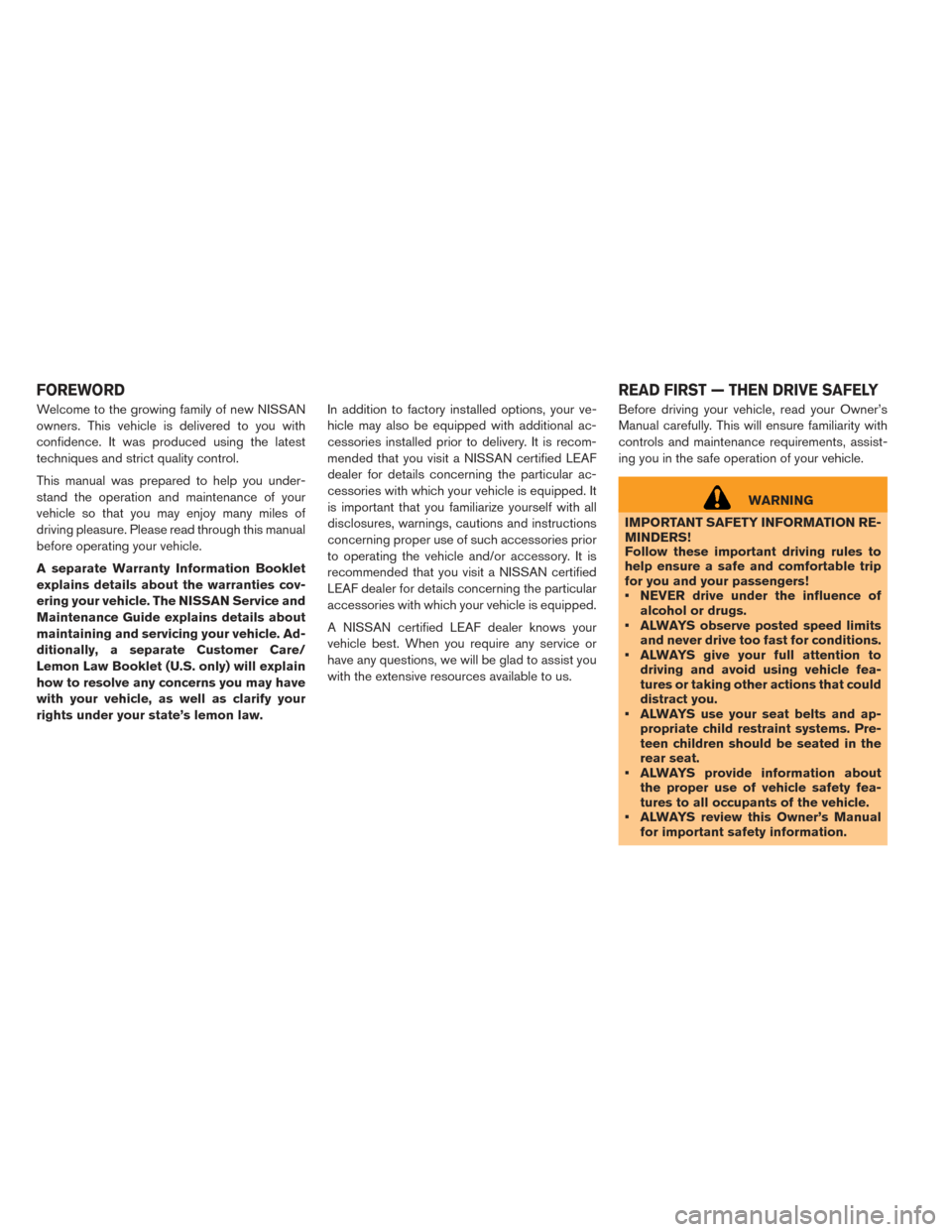
Welcome to the growing family of new NISSAN
owners. This vehicle is delivered to you with
confidence. It was produced using the latest
techniques and strict quality control.
This manual was prepared to help you under-
stand the operation and maintenance of your
vehicle so that you may enjoy many miles of
driving pleasure. Please read through this manual
before operating your vehicle.
A separate Warranty Information Booklet
explains details about the warranties cov-
ering your vehicle. The NISSAN Service and
Maintenance Guide explains details about
maintaining and servicing your vehicle. Ad-
ditionally, a separate Customer Care/
Lemon Law Booklet (U.S. only) will explain
how to resolve any concerns you may have
with your vehicle, as well as clarify your
rights under your state’s lemon law.In addition to factory installed options, your ve-
hicle may also be equipped with additional ac-
cessories installed prior to delivery. It is recom-
mended that you visit a NISSAN certified LEAF
dealer for details concerning the particular ac-
cessories with which your vehicle is equipped. It
is important that you familiarize yourself with all
disclosures, warnings, cautions and instructions
concerning proper use of such accessories prior
to operating the vehicle and/or accessory. It is
recommended that you visit a NISSAN certified
LEAF dealer for details concerning the particular
accessories with which your vehicle is equipped.
A NISSAN certified LEAF dealer knows your
vehicle best. When you require any service or
have any questions, we will be glad to assist you
with the extensive resources available to us.
Before driving your vehicle, read your Owner’s
Manual carefully. This will ensure familiarity with
controls and maintenance requirements, assist-
ing you in the safe operation of your vehicle.
WARNING
IMPORTANT SAFETY INFORMATION RE-
MINDERS!
Follow these important driving rules to
help ensure a safe and comfortable trip
for you and your passengers!
• NEVER drive under the influence of alcohol or drugs.
• ALWAYS observe posted speed limits and never drive too fast for conditions.
• ALWAYS give your full attention to driving and avoid using vehicle fea-
tures or taking other actions that could
distract you.
• ALWAYS use your seat belts and ap- propriate child restraint systems. Pre-
teen children should be seated in the
rear seat.
• ALWAYS provide information about the proper use of vehicle safety fea-
tures to all occupants of the vehicle.
• ALWAYS review this Owner’s Manual for important safety information.
FOREWORD READ FIRST — THEN DRIVE SAFELY
Page 6 of 424
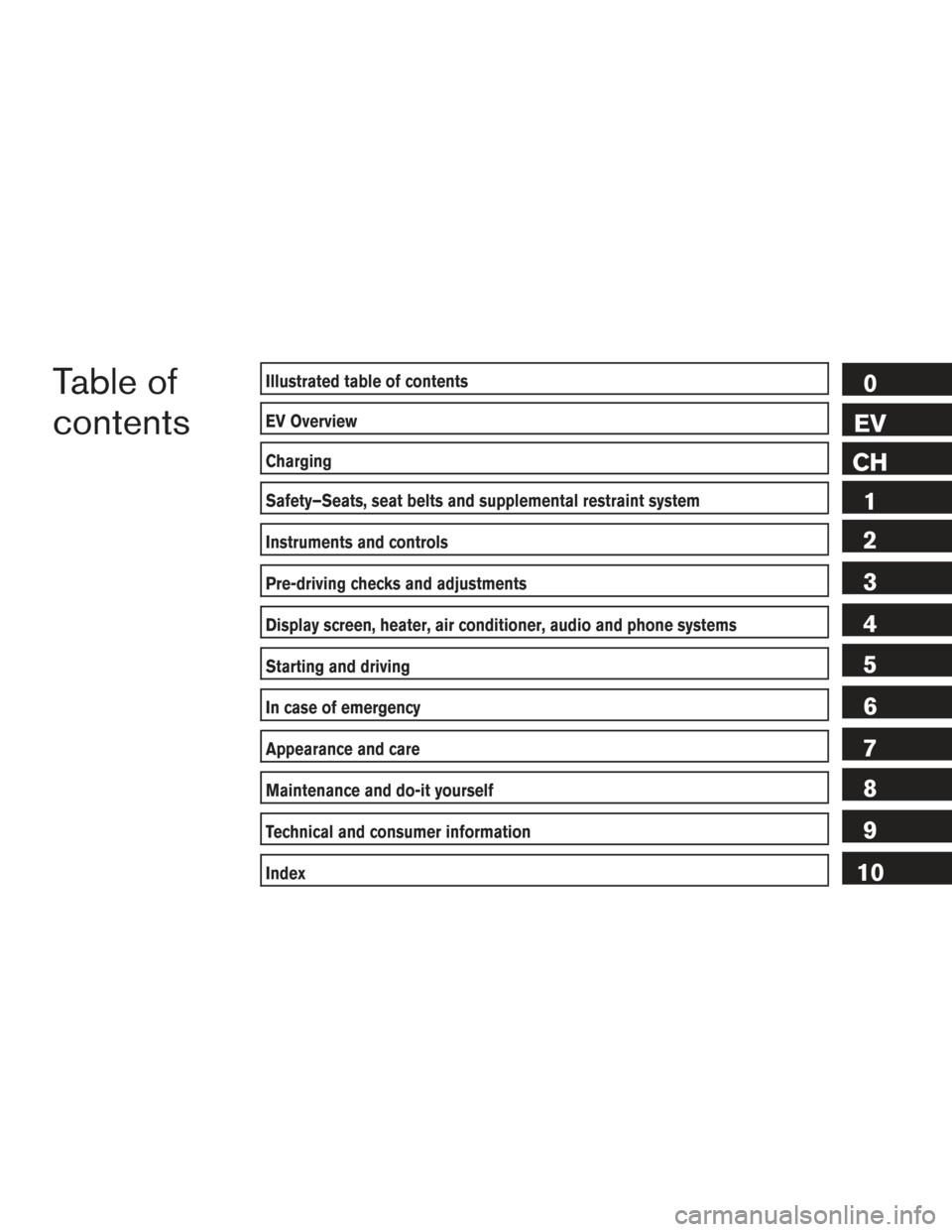
Table of
contentsIllustrated table of contents
EV Overview
Charging
Safety–Seats, seat belts and supplemental restraint system
Instruments and controls
Pre-driving checks and adjustments
Display screen, heater, air conditioner, audio and phone systems
Starting and driving
In case of emergency
Appearance and care
Maintenance and do-it yourself
Technical and consumer information
Index
0
EV
CH 1
2
3
4
5
6
7
8
9
10
Page 20 of 424
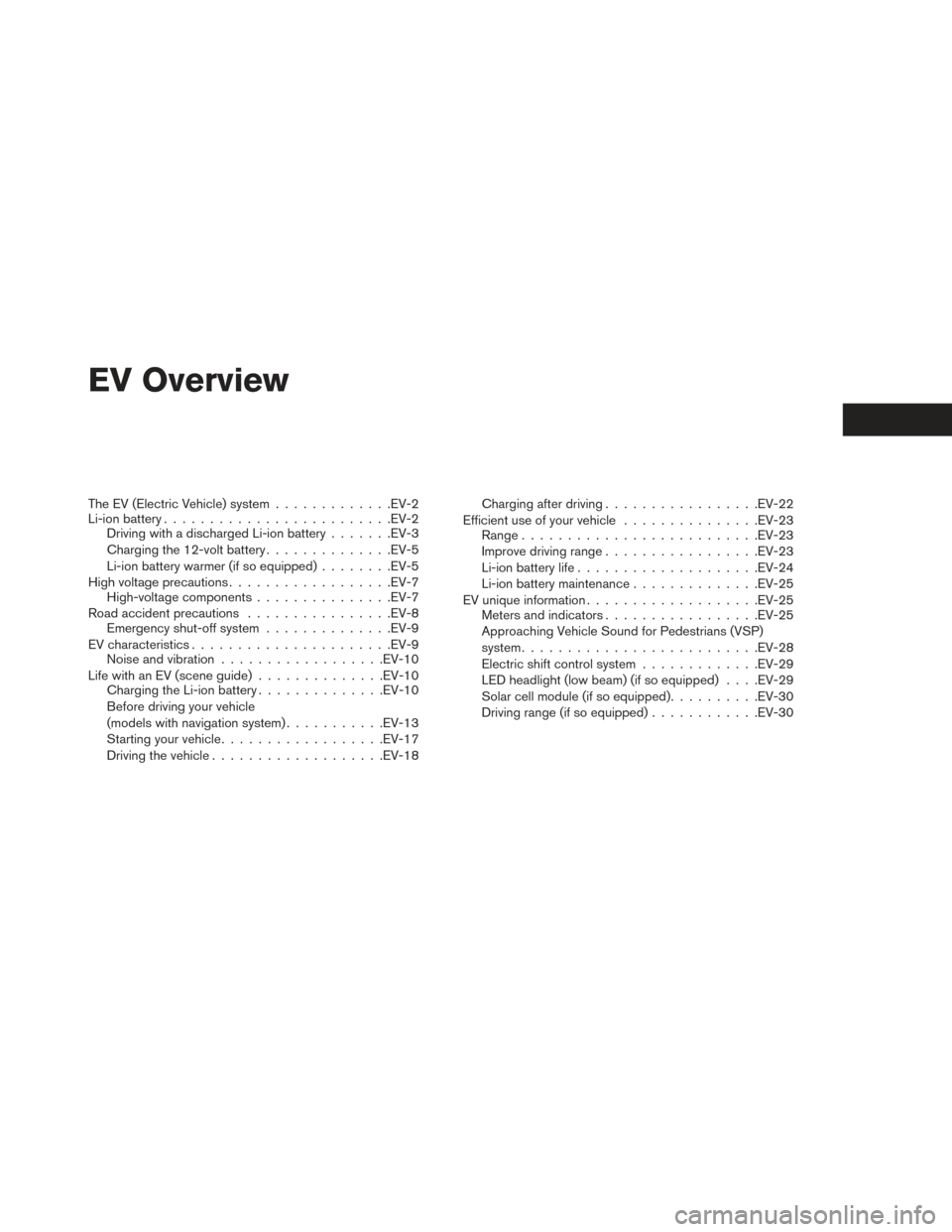
EV Overview
The EV (Electric Vehicle) system.............EV-2
Li-ion battery ........................ .EV-2
Driving with a discharged Li-ion battery .......EV-3
Charging the 12-volt battery ..............EV-5
Li-ion battery warmer (if so equipped) ........EV-5
High voltage precautions ................. .EV-7
High-voltage components ...............EV-7
Road accident precautions ................EV-8
Emergency shut-off system ..............EV-9
EV characteristics ..................... .EV-9
Noise and vibration ................. .EV-10
Life with an EV (scene guide) ..............EV-10
Charging the Li-ion battery ..............EV-10
Before driving your vehicle
(models with navigation system) ...........EV-13
Starting your vehicle ................. .EV-17
Driving the vehicle .................. .EV-18Charging after driving
................ .EV-22
Efficient use of your vehicle ...............EV-23
Range ......................... .EV-23
Improve driving range ................ .EV-23
Li-ion battery life ................... .EV-24
Li-ion battery maintenance ..............EV-25
EV unique information .................. .EV-25
Meters and indicators ................ .EV-25
Approaching Vehicle Sound for Pedestrians (VSP)
system ......................... .EV-28
Electric shift control system .............EV-29
LED headlight (low beam) (if so equipped) . . . .EV-29
Solar cell module (if so equipped) ..........EV-30
Driving range (if so equipped) ............EV-30
Page 26 of 424
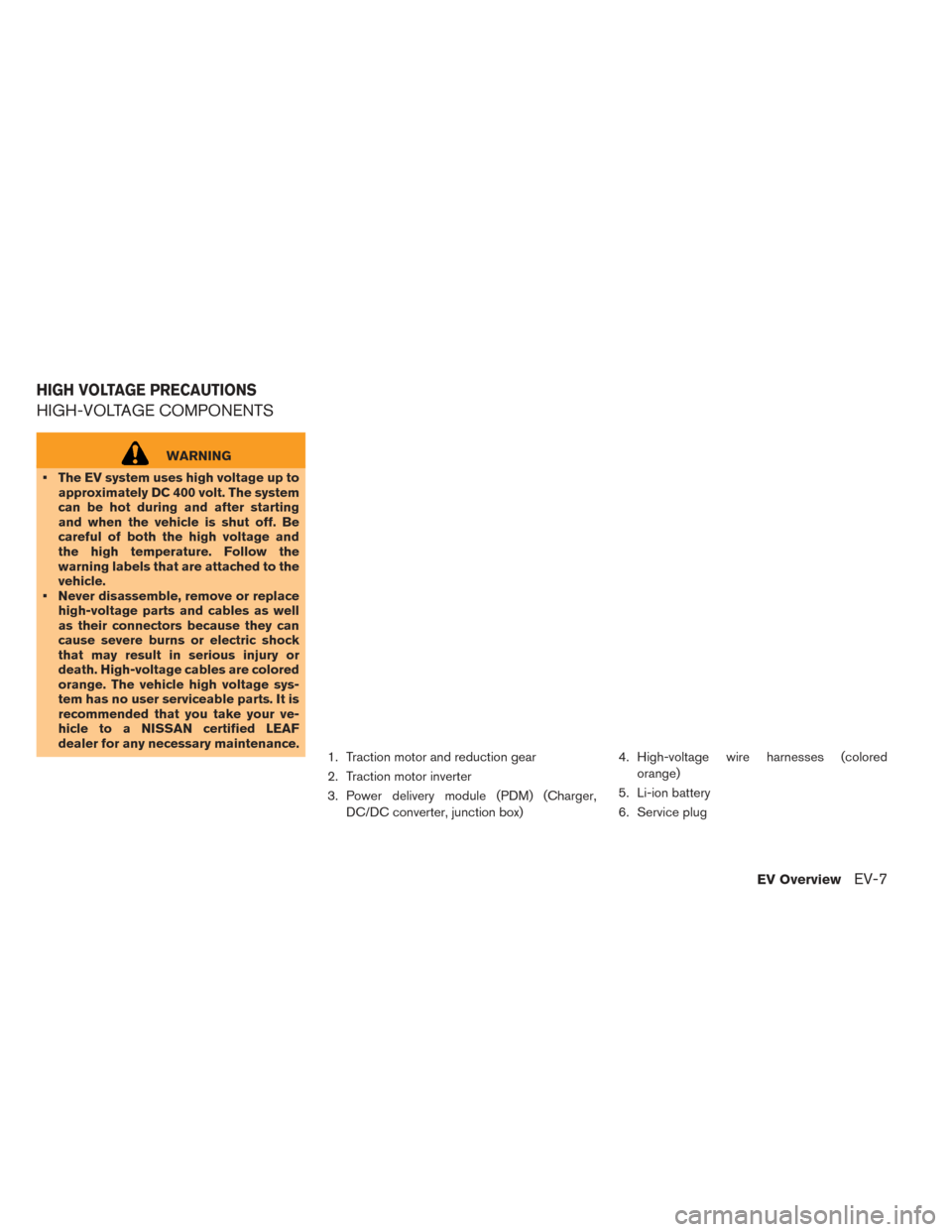
HIGH-VOLTAGE COMPONENTS
WARNING
• The EV system uses high voltage up to approximately DC 400 volt. The system
can be hot during and after starting
and when the vehicle is shut off. Be
careful of both the high voltage and
the high temperature. Follow the
warning labels that are attached to the
vehicle.
• Never disassemble, remove or replace high-voltage parts and cables as well
as their connectors because they can
cause severe burns or electric shock
that may result in serious injury or
death. High-voltage cables are colored
orange. The vehicle high voltage sys-
tem has no user serviceable parts. It is
recommended that you take your ve-
hicle to a NISSAN certified LEAF
dealer for any necessary maintenance. 1. Traction motor and reduction gear
2. Traction motor inverter
3. Power delivery module (PDM) (Charger,
DC/DC converter, junction box) 4. High-voltage wire harnesses (colored
orange)
5. Li-ion battery
6. Service plug
HIGH VOLTAGE PRECAUTIONS
EV OverviewEV-7
Page 42 of 424
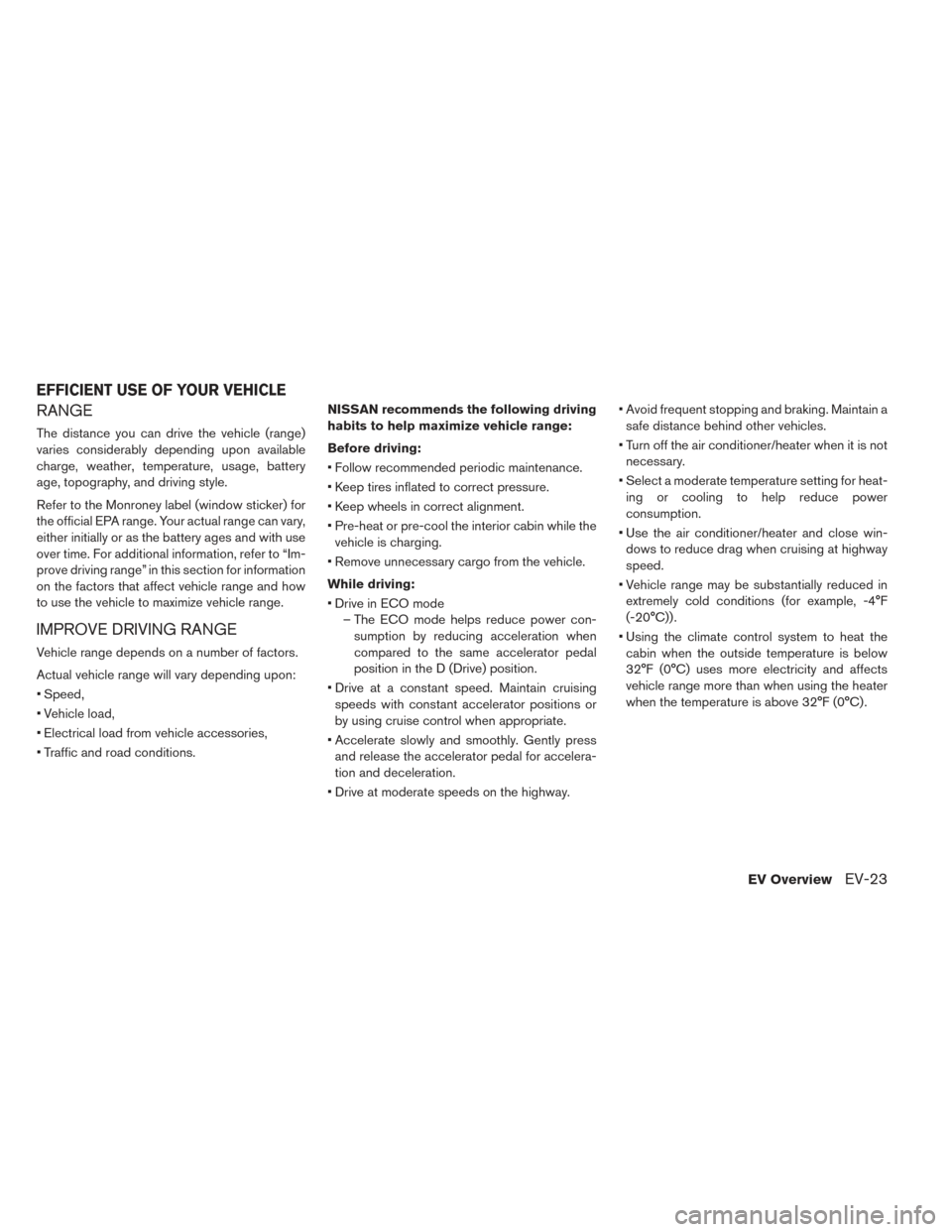
RANGE
The distance you can drive the vehicle (range)
varies considerably depending upon available
charge, weather, temperature, usage, battery
age, topography, and driving style.
Refer to the Monroney label (window sticker) for
the official EPA range. Your actual range can vary,
either initially or as the battery ages and with use
over time. For additional information, refer to “Im-
prove driving range” in this section for information
on the factors that affect vehicle range and how
to use the vehicle to maximize vehicle range.
IMPROVE DRIVING RANGE
Vehicle range depends on a number of factors.
Actual vehicle range will vary depending upon:
• Speed,
• Vehicle load,
• Electrical load from vehicle accessories,
• Traffic and road conditions.NISSAN recommends the following driving
habits to help maximize vehicle range:
Before driving:
• Follow recommended periodic maintenance.
• Keep tires inflated to correct pressure.
• Keep wheels in correct alignment.
• Pre-heat or pre-cool the interior cabin while the
vehicle is charging.
• Remove unnecessary cargo from the vehicle.
While driving:
• Drive in ECO mode – The ECO mode helps reduce power con-sumption by reducing acceleration when
compared to the same accelerator pedal
position in the D (Drive) position.
• Drive at a constant speed. Maintain cruising speeds with constant accelerator positions or
by using cruise control when appropriate.
• Accelerate slowly and smoothly. Gently press and release the accelerator pedal for accelera-
tion and deceleration.
• Drive at moderate speeds on the highway. • Avoid frequent stopping and braking. Maintain a
safe distance behind other vehicles.
• Turn off the air conditioner/heater when it is not necessary.
• Select a moderate temperature setting for heat- ing or cooling to help reduce power
consumption.
• Use the air conditioner/heater and close win- dows to reduce drag when cruising at highway
speed.
• Vehicle range may be substantially reduced in extremely cold conditions (for example, -4°F
(-20°C)) .
• Using the climate control system to heat the cabin when the outside temperature is below
32°F (0°C) uses more electricity and affects
vehicle range more than when using the heater
when the temperature is above 32°F (0°C) .
EFFICIENT USE OF YOUR VEHICLE
EV OverviewEV-23
Page 44 of 424
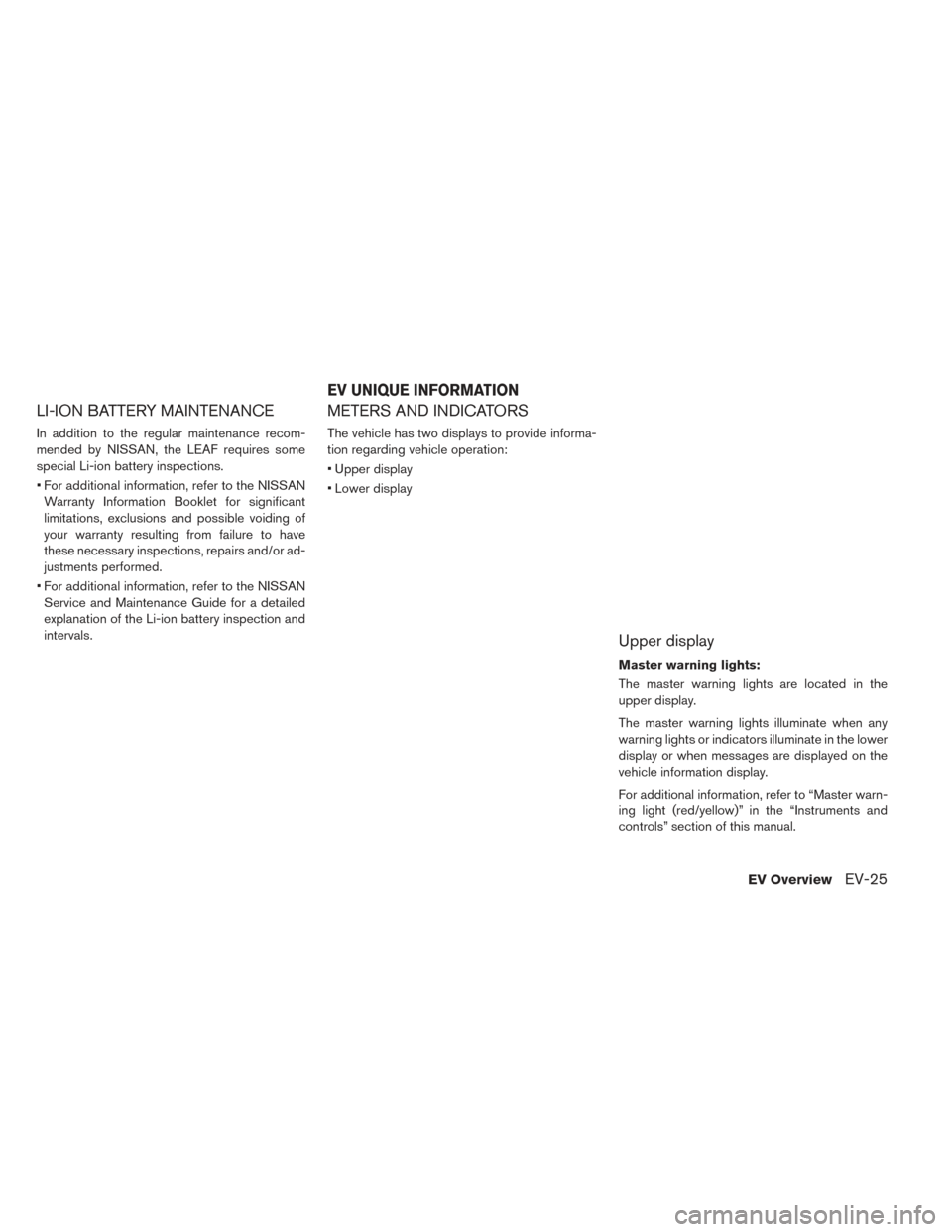
LI-ION BATTERY MAINTENANCE
In addition to the regular maintenance recom-
mended by NISSAN, the LEAF requires some
special Li-ion battery inspections.
• For additional information, refer to the NISSANWarranty Information Booklet for significant
limitations, exclusions and possible voiding of
your warranty resulting from failure to have
these necessary inspections, repairs and/or ad-
justments performed.
• For additional information, refer to the NISSAN Service and Maintenance Guide for a detailed
explanation of the Li-ion battery inspection and
intervals.
METERS AND INDICATORS
The vehicle has two displays to provide informa-
tion regarding vehicle operation:
• Upper display
• Lower display
Upper display
Master warning lights:
The master warning lights are located in the
upper display.
The master warning lights illuminate when any
warning lights or indicators illuminate in the lower
display or when messages are displayed on the
vehicle information display.
For additional information, refer to “Master warn-
ing light (red/yellow)” in the “Instruments and
controls” section of this manual.
EV UNIQUE INFORMATION
EV OverviewEV-25
Page 84 of 424
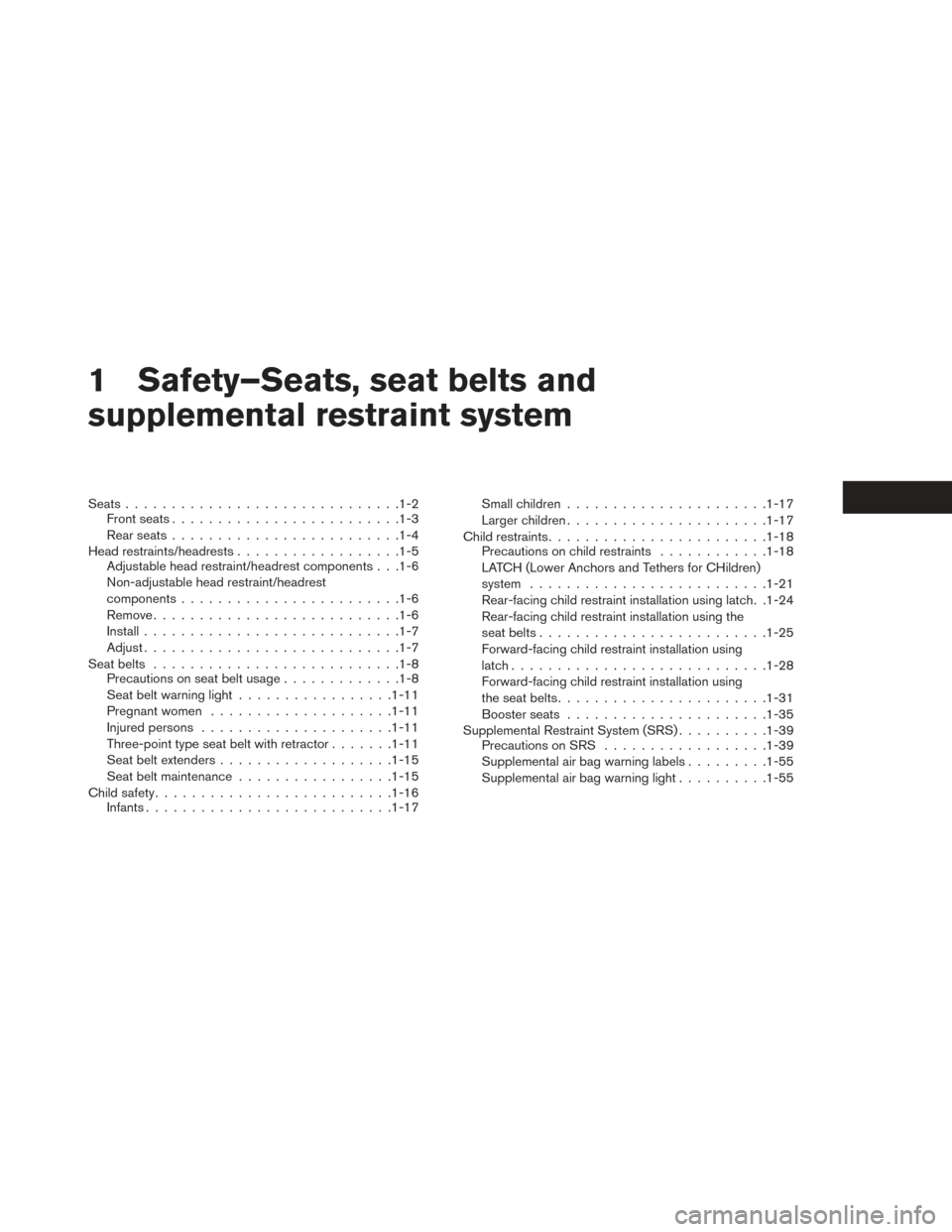
1 Safety–Seats, seat belts and
supplemental restraint system
Seats............................. .1-2
Front seats ........................ .1-3
Rear seats ........................ .1-4
Head restraints/headrests ................. .1-5
Adjustable head restraint/headrest components . . .1-6
Non-adjustable head restraint/headrest
components ....................... .1-6
Remove .......................... .1-6
Install ........................... .1-7
Adjust ........................... .1-7
Seat belts .......................... .1-8
Precautions on seat belt usage .............1-8
Seat belt warning light ................ .1-11
Pregnant women ................... .1-11
Injured persons .................... .1-11
Three-point type seat belt with retractor .......1-11
Seat belt extenders .................. .1-15
Seat belt maintenance ................ .1-15
Child safety ......................... .1-16
Infants .......................... .1-17Small children
..................... .1-17
Larger children ..................... .1-17
Child restraints ....................... .1-18
Precautions on child restraints ............1-18
LATCH (Lower Anchors and Tethers for CHildren)
system ......................... .1-21
Rear-facing child restraint installation using latch. .1-24
Rear-facing child restraint installation using the
seat belts ........................ .1-25
Forward-facing child restraint installation using
latch ........................... .1-28
Forward-facing child restraint installation using
the seat belts ...................... .1-31
Booster seats ..................... .1-35
Supplemental Restraint System (SRS) ..........1-39
Precautions on SRS ................. .1-39
Supplemental air bag warning labels .........1-55
Supplemental air bag warning light ..........1-55
Page 98 of 424
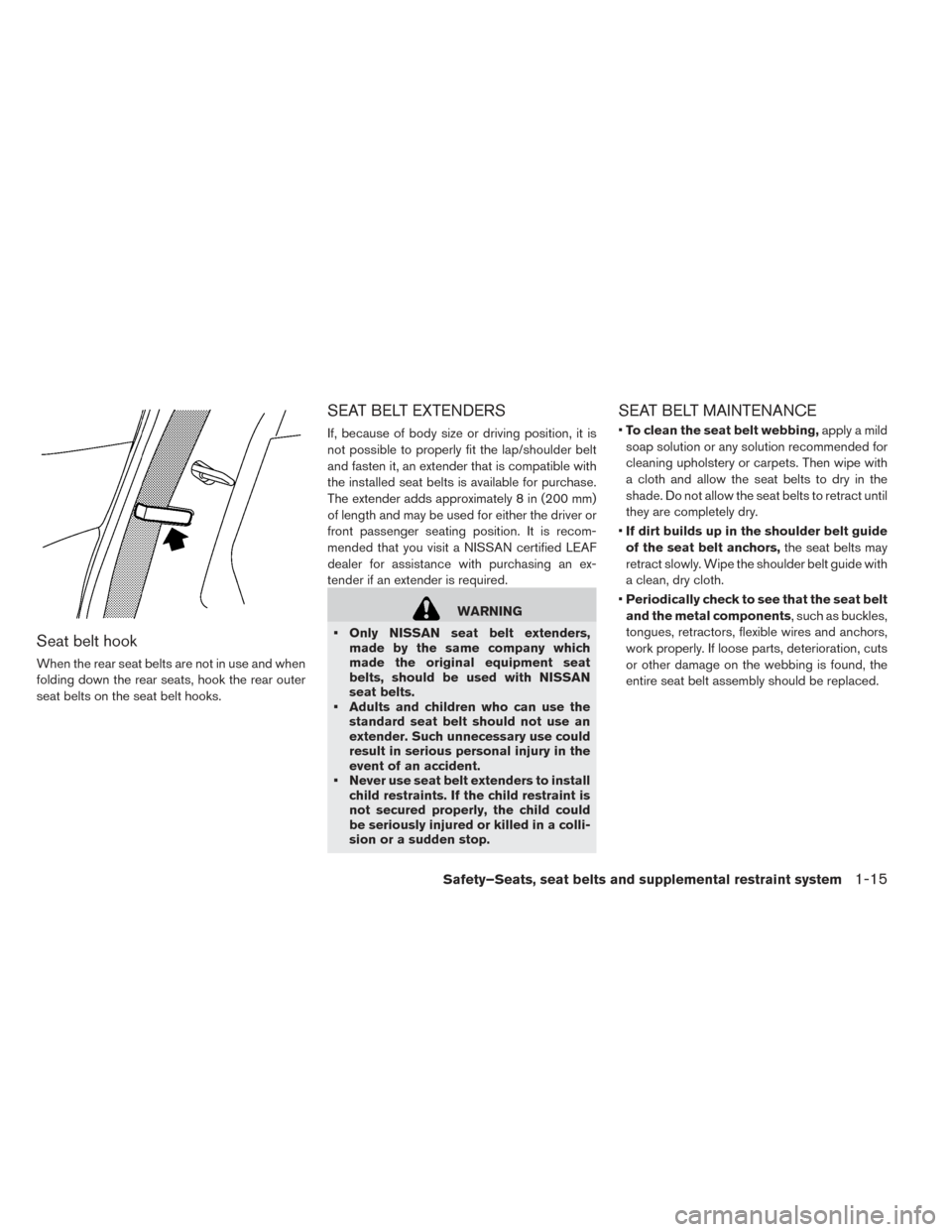
Seat belt hook
When the rear seat belts are not in use and when
folding down the rear seats, hook the rear outer
seat belts on the seat belt hooks.
SEAT BELT EXTENDERS
If, because of body size or driving position, it is
not possible to properly fit the lap/shoulder belt
and fasten it, an extender that is compatible with
the installed seat belts is available for purchase.
The extender adds approximately 8 in (200 mm)
of length and may be used for either the driver or
front passenger seating position. It is recom-
mended that you visit a NISSAN certified LEAF
dealer for assistance with purchasing an ex-
tender if an extender is required.
WARNING
• Only NISSAN seat belt extenders, made by the same company which
made the original equipment seat
belts, should be used with NISSAN
seat belts.
• Adults and children who can use the standard seat belt should not use an
extender. Such unnecessary use could
result in serious personal injury in the
event of an accident.
• Never use seat belt extenders to install child restraints. If the child restraint is
not secured properly, the child could
be seriously injured or killed in a colli-
sion or a sudden stop.
SEAT BELT MAINTENANCE
•To clean the seat belt webbing, apply a mild
soap solution or any solution recommended for
cleaning upholstery or carpets. Then wipe with
a cloth and allow the seat belts to dry in the
shade. Do not allow the seat belts to retract until
they are completely dry.
• If dirt builds up in the shoulder belt guide
of the seat belt anchors, the seat belts may
retract slowly. Wipe the shoulder belt guide with
a clean, dry cloth.
• Periodically check to see that the seat belt
and the metal components, such as buckles,
tongues, retractors, flexible wires and anchors,
work properly. If loose parts, deterioration, cuts
or other damage on the webbing is found, the
entire seat belt assembly should be replaced.
Safety–Seats, seat belts and supplemental restraint system1-15